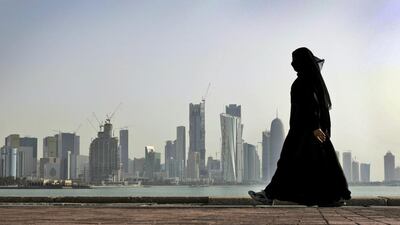Qatar is set to continue to tap its foreign currency reserves and borrow abroad to support its economy, as the world’s biggest liquefied natural gas exporter seeks to stem an economic slowdown following more than two months of a political and economic rift with four Arab states, economists said.
Qatar’s woes began on June 5 when the UAE, Saudi Arabia, Bahrain and Egypt severed diplomatic relations with Doha and cut off air, sea and land access to the country over its support for “terrorist groups aiming to destabilise the region”. The dispute is the most serious between GCC members since the organisation’s creation in 1981.
“An escalation of the crisis could result in more damage to the Qatari economy, especially if the Arab states impose additional punitive economic measures,” said Ayham Kamel director of the Middle East and North Africa region at Eurasia Group. “The central bank will have to provide liquidity and manage to address increases in the withdrawal of foreign deposits."
Doha’s non-oil economic growth could slow to as much as 3.6 per cent in 2017 from about 5.6 per cent last year and the prolonging of the crisis will further erode confidence in the economy, according to Abu Dhabi Commercial Bank and Economist Intelligence Unit analysts. For the month of June, imports plunged 40 percent annually, while foreign reserves dropped 30 per cent, according to the central bank, and foreign deposits at Qatar’s banks fell the most in almost two years in the month, tightening liquidity available to businesses and the government, according to Bloomberg.
“The government is probably subsidizing or supporting the shift in the trade patterns and costs associated,” said Mr Kamel. “However, there are no signals that the costs are prohibitive or that eventually a new equilibrium will not emerge. It will probably be a less efficient structure compared to ties to the GCC. The government might liquidate sovereign assets in the process.”
The crisis has eroded investor confidence in the country, its stock market, put pressure on its currency’s peg to the dollar, and led to regional and international banks restricting liquidity to Doha’s banking system. To retain and shore up their deposits Qatari banks have reportedly tried to mollify nervous customers by raising interest rates.
“In case of a lengthening of the crisis and worsening of sanctions (moving toward financial sanctions), we can expect some deposit outflows,” according to a BNP Paribas report, adding that estimates of Qatari banks external liabilities on GCC vary from US$20 billion or 10 per cent of GDP to $35bn or 18 per cent of GDP.
Also in June, Standard & Poor’s Global Ratings lowered Qatar’s long-term rating a notch down to AA- and placed it on credit-watch with negative implications because of concerns of the country’s widening fiscal balance.
The credit downgrade will increase borrowing costs for Qatar, which sold last year a $9 billion international bond to plug its budget shortfalls.
The situation is likely to be exacerbated by the fact that Qatar now is forecast to post a fiscal deficit of 2.2 per cent of GDP rather than a surplus next year, because of the economic and political rift, according to BMI Research.
BMI had forecast in June a fiscal surplus for Qatar next year and a fiscal deficit of 1.2 per cent of GDP for this year. The country now is projected to post a 3.8 per cent deficit for this year, compared with 9 per cent deficit in 2016.
“In a time of high global liquidity, low interest rates I don’t think they will want to continue using their reserves,” said Monica Malik, chief economist at Abu Dhabi Commercial Bank.
“They showed a willingness to support the domestic banking sector which was necessary at the beginning of the crisis. But they would prefer not to draw down on their reserves and rather tap the international liquidity and low interest rate environment. As their debts, mature they’ll want to tap international markets to raise capital in whatever form.”
Even Qatar’s plans to ramp up LNG production faces headwinds. Questions surround the economics of the country's decision to increase its LNG exports by 30 per cent over the next five to seven years after removing the moratorium on development of the giant North Field, as Doha may encounter issues securing long-term off take agreements.
“In the current market environment, Qatar is not likely to find long-term buyers for 25 million tonnes per annum (Mtpa) of liquefaction capacity,” according to Energy Aspects.

